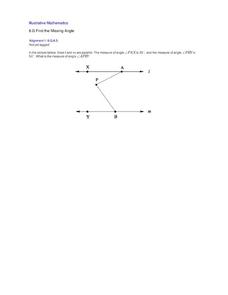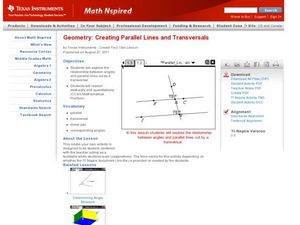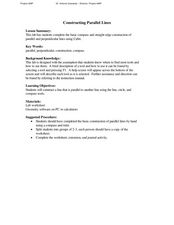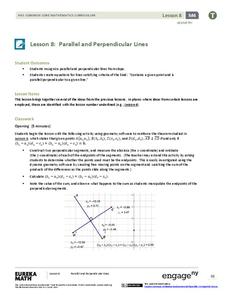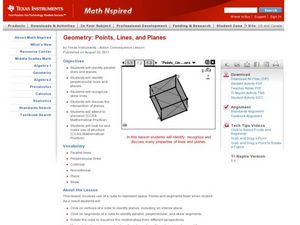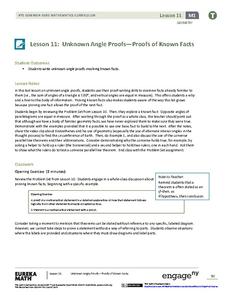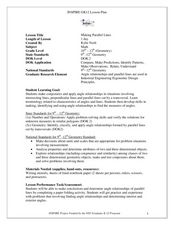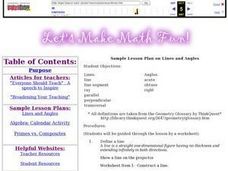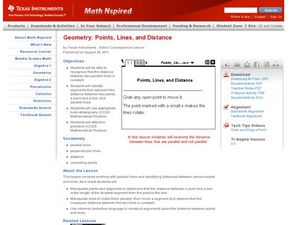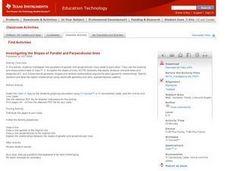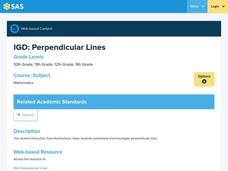EngageNY
Looking More Carefully at Parallel Lines
Can you prove it? Making assumptions in geometry is commonplace. This resource requires mathematicians to prove the parallel line postulate through constructions. Learners construct parallel lines with a 180-degree rotation and then...
Radford University
Parallel Lines, Transversals, and Angles: What’s the Connection?
Streets, bridges, and intersections, oh my! Parallel lines and transversals are a present in the world around us. Learners begin by discovering the relationship of the angles formed by parallel lines and a transversal. They then...
Curated OER
Angles Formed By Parallel Lines
Young scholars explore the concept of angles formed by parallel lines.They graph two parallel lines cut by a transversal, then measure the angles formed by the transversal and record the data in a table. Learners make conjectures about...
Illustrative Mathematics
Find the Missing Angle
This one activity requires young geometers to pull together information they are currently learning with things they have learned previously. Here they rely on understanding something about parallel lines, alternative interior angles,...
Curated OER
Creating Parallel Lines and Transversals
Have your class create parallel lines. Students will learn how to identify the different angles created by a parallel line cut by a transversal. Then, they identify and name similar and different angles.
Curated OER
Parallel and Perpendicular Lines
Tenth graders explore parallel and perpendicular lines. In this geometry lesson, 10th graders investigate the relationships associated with parallel lines and transversals, perpendicular lines, and the angles formed by these...
Curated OER
Constructing Parallel Lines
Students construct parallel lines using a protractor and a straightedge. In this geometry lesson, students identify the properties of parallel lines. They use Cabri to graph and observe the lines.
EngageNY
Motion Along a Line – Search Robots Again
We can mathematically model the path of a robot. Learners use parametric equations to find the location of a robot at a given time. They compare the paths of multiple robots looking for parallel and perpendicular relationships and...
EngageNY
Parallel and Perpendicular Lines
Use what you know about parallel and perpendicular lines to write equations! Learners take an equation of a line and write an equation of a line that is parallel or perpendicular using slope criteria. They then solve problems to...
EngageNY
Making Scale Drawings Using the Parallel Method
How many ways can you create a dilation? Many! Individuals strengthen their understanding of dilations by using various methods to create them. The new technique builds on pupils' understanding of the ratio method. Using the ratio,...
Curated OER
Identify Polygons: Algebra/Geometry Institute
Eighth graders classify geometric figures. In this polygon lesson, 8th graders identify given geometric figures. They compare and contrast different polygons. Students name line segments, identify parallel lines, and...
Texas Instruments
Points, Lines, and Planes
Students solve problems dealing with points, lines and planes. In this geometry lesson, students differentiate between parallel lines and planes. They find the intersection of lines and planes.
Curated OER
Perpendicular Lines in the Coordinate Plane
Students investigate the relationship between perpendicular and parallel lines on a coordinate plane. In this geometry lesson, students differentiate lines based on their slopes.
EngageNY
Unknown Angle Proofs—Proofs of Known Facts
Lead the class in a Greek history lesson with a geometric twist. Pupils relate a short video about geometric properties to modern-day methods of solving for unknown angles. They discuss parallel line theorems and complete...
Curated OER
Special Angles on Parallel Lines
Tenth graders investigate parallel lines and their special angles cut by a transversal. For this geometry lesson, 10th graders identify and find corresponding, alternate interior, and alternate exterior angles formed when parallel lines...
Curated OER
Making Parallel Lines
Students differentiate between parallel and perpendicular lines. In this geometry instructional activity, students make conjectures and apply it to solve real life situations. They collect data and make predictions based on the data.
Curated OER
Sample Lesson Plan on Lines and Angles
Student complete worksheet using the definitions of lines and angle vocabulary. They define the word and follow a direction given on the worksheet such "construct a line." They complete an online tutorial on how to measure angles using a...
Curated OER
Points, Lines, and Distance
Students calculate the distance between two points. In this geometry lesson, students define the meaning of the distance between parallel lines. They find the point of intersection of other lines.
Curated OER
Investigating the Slopes of Parallel and Perpendicular Lines
High schoolers investigate parallel and perpendicular lines. They use Cabri Jr. to construct and explore the relationships between the slopes of parallel and perpendicular lines. The drawing and measurement tools available with Cabri Jr....
Curated OER
Perpendicular Lines
Students differentiate between parallel and perpendicular lines. In this geometry lesson, students identify the different angles created by perpendicular lines and parallel lines. They name the angles that are form when parallel lines...
Curated OER
Parallel-o-Home
Students investigate the usage of parallel and perpendicular shapes in the real world. In this geometry lesson, students investigate shapes for properties that are related to the real world. They relate all the properties of shape tot he...
Curated OER
Angles, Lines and Transversals
Students identify and determine angle pair relationships. In this geometry activity, students identify different angles of parallel lines that are cut by transversals. They identify interior and exterior angles after watching a video.
EngageNY
Translations
Learn through constructions! Learners examine a translation using constructions and define the translation using a vector. Pupils then construct parallel lines to determine the location of a translated image and use the vector as a guide.
Mathematics Vision Project
Module 5: Modeling with Geometry
Solids come in many shapes and sizes. Using geometry, scholars create two-dimensional cross-sections of various three-dimensional objects. They develop the lesson further by finding the volume of solids. The module then shifts...



